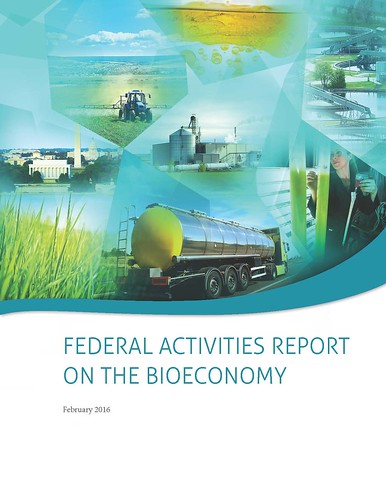
5/4/2016 UPDATE:
Bioeconomy Webinar Information:
Thursday, May 5, 2 p.m.–4 p.m. Eastern Time
Session Link: https://thinktank.inl.gov/login.html?sessionID=59
Session Passkey: 123
Call in: +1 (562) 247-8422
Access Code: 287-084-886
The USDA and other federal agencies recently released the Federal Activities Report on the Bioeconomy (FARB) documenting federal agency activities aimed at helping to develop and support the "bioeconomy" - an emerging part of the overall U.S. economy. Emphasis is specifically placed on the production and use of biofuels, bioproducts, and biopower. USDA Chief Scientist and Under Secretary for Research, Education, and Economics (REE), Dr. Catherine Woteki, stresses these fuels, power, and products are produced using biomass--agricultural residues, grasses, energy crops, forestry trimmings, algae, and other sources--instead of fossil fuels.
The report also delves into the Billion Ton Bioeconomy Vision, an effort coordinated through the Biomass Research and Development (R&D) Board. Comprised of industry experts from the Departments of Energy (DOE), Agriculture (USDA), Interior (DOI), Transportation (DOT), Defense (DoD), and the Environmental Protection Agency (EPA), the National Science Foundation (NSF), and the Office of Science and Technology Policy (OSTP), the Board is committed to collaboration among federal agencies on bioeconomy conceptions working to triple the size of today’s bioeconomy by 2030—to more than a billion tons of biomass.
Harry Baumes, Senior Executive Advisor to the Bioenergy Technologies Office and Director, Office of Energy Policy and New Uses, U.S. Department of Agriculture and Todd Campbell, Policy Advisor, Energy and Bioeconomy, Office of Rural Development, U.S. Department of Agriculture, co-led a listening session to gather information and engage stakeholders on how to build and grow the Billion Ton Bioeconomy. “Expanding the bioeconomy in a sustainable manner will increase energy diversity and long-term security. It will provide additional economic, environmental, and social benefits, such as reduced greenhouse gas emissions, job growth, and responsible management of diverse sources of biomass and waste materials,” said Baumes. He presented these findings during the international Biotechnology Innovation Organization (BIO) 13th annual World Congress on Industrial Biotechnology the week of April 18th in San Diego, CA. USDA was among the 907 industry leaders from 529 companies, 32 countries and 31 states, including the District of Columbia. “With leadership across the administration, the Billion Ton Bioeconomy vision could grow the entire bioeconomy supply chain—through feedstock development and production, technology development, conversion, production of renewable chemicals and other biobased products, and marketing and distribution to alternative end use.”
The FARB outlines actions taken that will result in a greener, stronger nation with diverse, new economic sectors that enhance U.S. competitiveness. This includes:
- An overview of the Billion Ton Bioeconomy Vision
- Preliminary analyses of the expected benefits of a Billion Ton Bioeconomy
- A compendium of federal activities that currently support the bioeconomy
- Details on interagency activities that aim to grow the bioeconomy
An example of the cross federal agency efforts includes DOE research, development, and demonstration for biofuels and bioproducts within the Bioenergy Technologies Office BETO and other offices in the Sustainable Transportation sector at EERE. Similarly, work is being done within the Office of Science, the Advanced Research Projects Agency-Energy. At USDA, much of the research and development focuses on the production, quality, and integration of feedstocks into commercial agriculture production of food, fiber, and forestry.
“USDA also has programs and activities that promote end markets for biofuels, heat and biopower, and bio-based products. This work is carried out across many USDA offices. Many bio-based products are already available for purchase, including products certified by USDA’s BioPreferred program. However, others still need technological and/or market development to reduce costs, improve quality and/or performance, such as cellulosic biofuels that can directly replace gasoline,” Baumes added.
As the drive to build and grow the Billion Ton Bioeconomy moves forward, the U.S. is continuing to work towards developing a diverse energy portfolio and transition to a renewable, clean energy future. The Federal government is taking the lead working with academia, industry, and non-governmental organizations to provide the science, technology, and policy support to accelerate the deployment of new manufacturing facilities using innovative processes and using biomass as a feedstock.
The Biomass Research and Development (R&D) Board will be hosting a series of workshops and webinars aimed at gathering input from the public on numerous topics, which we will be released later this year. The next listening session will be a webinar, titled “Building a Billion Ton Bioeconomy in the United States,” will be held Thursday, May 5, 2 p.m.–4 p.m. Eastern Time. Click to register.



